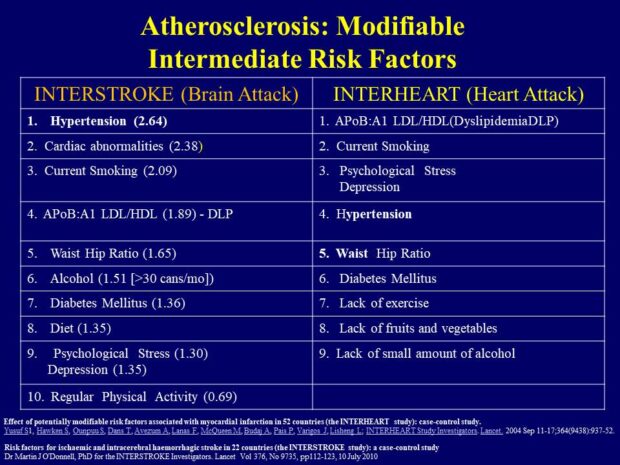Heart specialist advises people to know risk factors to prevent Cardiovascular Diseases
Despite the COVID-19 global pandemic, cardiovascular diseases (CVDs) remain to be the most common causes of death in the country and around the world. Heart attack and stroke top the list, followed closely by cancer. But how much do we know about these diseases? A known cardiologist weighs in on the importance of knowing your risk factors to prevent, treat and manage cardiovascular diseases.
During the Heart Talk of Manila Doctors Hospital (MDH) last February 14, Dr. Dante D. Morales Head of the Cardiovascular Center (CVC) at MDH, points out the importance of recognizing your risk factors as the first step in curbing potential heart and brain diseases. Citing global researches to which he has been also one of the researchers, the CVC Head at MDH says that there are nine (9) modifiable risk factors for heart attack and ten (10) for stroke or brain attack observed worldwide. For heart attack, INTERHEART showed the risk factors in the order of importance namely: high cholesterol, smoking, depression or anxiety, hypertension, abdominal obesity, diabetes, lack of exercise, lack of fruits and vegetables and lack of small amount of alcohol. For stroke or brain attack, the INTERSTROKE study demonstrated the most common risk factor is hypertension. In the Philippines alone, the said risk factor is also a top contributor to heart attack. The risk factors for heart and brain attack are similar but differ only in priority and presence of cardiac abnormalities (namely atrial fibrillation) for stroke, as well as alcohol being a risk factor for stroke but not for heart attack. “It’s important that we know at the onset the risk factors so we will also know how to prevent, lessen, and cure them”, he added.
Interventions for Heart Disease Prevention
Dr. Morales also emphasizes that addressing and lessening the modifiable risk factors involve two approaches: the individual and population approaches. For the individual approach, one can personally focus in lessening their risk factors, while population approach is a collective contribution involving the same, but with governmental interventions. This entails CVD prevention in the barangay, city, province, and the whole country. He cited a study called Prospective Urban and Rural Epidemiology (PURE) with more than 200,000 respondents in 22 countries around the world, including the Philippines. This study shows the correlation of developing cardiovascular diseases in urban and rural population and among the different social classes in a country namely high, middle, and low income. With 5,000 respondents in the Philippines distributed in rural and urban areas and among the social classes, the study shows three main factors for increased cardiovascular disease prevalence in the country. These are (1) drug availability and affordability, (2) educational attainment and (3) economic status. The Cardiologist has noted that rising prices of medicines for cardiovascular diseases and lack of information about their health condition and which medicines to buy aggravate the CVD situation in the country. Apart from these, he also noted that the government should also be able to provide open areas and parks for recreation and exercise to promote healthier and more active lifestyle among Filipinos. “Food availability and nutrition also play a vital role in ensuring a healthy heart and body”. He also stresses the importance of efficient farm to market products and produce to encourage more people to consume healthier, available and affordable food, especially fruits and vegetables.
Link to COVID-19 and Modifiable and Non-Modifiable Risk Factors
Dr. Morales also clarified that while there have been many deaths from COVID-19 since 2020, even going up to the 6th leading cause of death at one time, CVDs and cancers are still more worrisome and more prevalent. He reiterated that the most vulnerable and high-risk segments of society to have fatal COVID-19 are persons with comorbidities such as heart disease, hypertension, diabetes, obesity, and other
illnesses that cause low immunity as well as senior citizens and healthcare front liners. The Cardiologist also mentions the non-modifiable risk factors that contribute to CVDs- these are the age, gender, family history, and ethnicity or race. According to him, family history of medical conditions plays a critical role in a person’s health. “If both parents have diabetes, a child has around 80% chance of having it too, while almost 50% chance if only one parent has it”, he adds. He also stressed that those with non-modifiable risk factors like increased age and family history of heritable diseases, the priority is to curb modifiable risk factors even more intensely to prevent serious CVDs. “We have to be very careful with those because if you are already ageing and have family history, you are at more risk and more vulnerable to CVDs if you also don’t improve your lifestyle and watch out for the changeable or alterable risk factors”. Dr. Morales also reminded everyone to be wary with their food take, noting that moderation is the key to becoming healthier. “As we age, we are now much concerned with both the quality and the quantity of our life. So for you to be able to eat what you want, make sure you also know how to moderate and monitor your behavior”, he added.

Get your heart screened and learn more about your heart health. Visit www.maniladoctors.com.ph for more information, or call (+632) 8558-0888 to know more about the Heart Month Packages.
Regular or periodic health screening and check-ups are still the best way to address and control the threats of CVDs, according to Dr. Morales. “At an early age, a person has to undergo risk screening, especially if they have identified non-modifiable risk factors”. He also added that the risk of dying yearly and even for ten years can be measured using applications like SCORE Cardiovascular Risk Chart based on age, gender, cholesterol, hypertension, smoking and diabetes. Having death rate of 10% per 10 years is bad and even worse if 20% for 10 years or an average of 2% per year. As risk factors are controlled, the risk for dying decreases. This serves as an incentive for patients to strictly comply with the doctor’s advice and prescriptions because even if they have no symptoms, they can be encouraged by the lowering of their risks to die. Noting the reluctance of people to visit hospitals because of the pandemic, Dr. Morales assured the public that as long as they follow health protocols, namely M D H – Mask-wearing, Distancing, and Hand hygiene, it is safe to visit the hospital for doctor’s consultation and tests. “Regular checkups are still a must based on the history and physical examination of the patient”, he added.

Get your heart screened and learn more about your heart health. Visit www.maniladoctors.com.ph for more information, or call (+632) 8558-0888 to know more about the Heart Month Packages.
The Heart Talk with Dr. Morales and hosted by Menchie Silvestre of Alagang Kapatid on TV5 is a Valentine Day offering of Manila Doctors Hospital. It aims to discuss pressing and relevant issues about heart health, recognize the risk factors, and learn ways on how to address and curb those in order to reduce mortality. Free consultation & assessment and free total cholesterol & uric acid tests were also given to the first 50 registrants. It is livestreamed via Zoom and broadcasted live on the official Facebook page of Manila Doctors Hospital.
ADVT.
